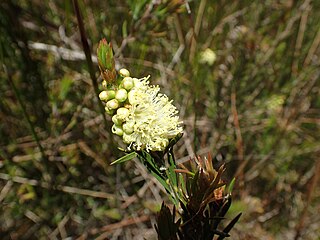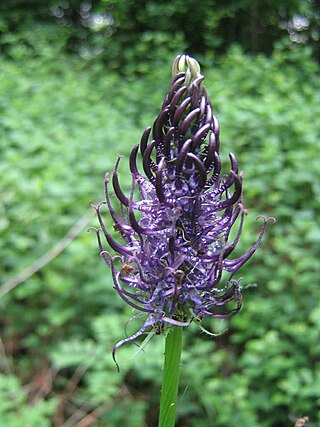
The jackalope is a mythical animal of North American folklore described as a jackrabbit with antelope horns. The word jackalope is a portmanteau of jackrabbit and antelope. Many jackalope taxidermy mounts, including the original, are made with deer antlers.

Megophryidae, commonly known as goose frogs, is a large family of frogs native to the warm southeast of Asia, from the Himalayan foothills eastwards, south to Indonesia and the Greater Sunda Islands in Maritime Southeast Asia, and extending to the Philippines. Fossil remains are also known from North America. As of 2014 it encompasses 246 species of frogs divided between five genera. For lack of a better vernacular name, they are commonly called megophryids.
Rampion is a common name for several plants, including:

Phyteuma is a genus of flowering plants in the family Campanulaceae, native to Europe and Morocco.

Phyteuma orbiculare, common name round-headed rampion or Pride of Sussex, is a herbaceous perennial plant of the genus Phyteuma belonging to the family Campanulaceae.
Franz Wilhelm Sieber, was a botanist and collector who travelled to Europe, the Middle East, Southern Africa and Australia.
NVC community CG3 is one of the calcicolous grassland communities in the British National Vegetation Classification system. It is one of four communities of rank, tussocky grassland associated with low levels of grazing, within the lowland calcicolous grassland group.
NVC community CG5 is one of the calcicolous grassland communities in the British National Vegetation Classification system. It is one of four communities of rank, tussocky grassland associated with low levels of grazing, within the lowland calcicolous grassland group.

Phyteuma spicatum, the spiked rampion, is a herbaceous perennial plant in the family Campanulaceae. It is common across much of Europe. Its common names include raiponce en épi (French), Ährige Teufelskralle (German), Ährige Rapunzel, and Raponzolo giallo (Italian).

Eucalyptus sieberi, commonly known as the silvertop ash or black ash, is a species of medium-sized to tall tree that is endemic to south-eastern Australia. It has rough bark on the trunk and the base of larger branches, and smooth bark above. It has lance-shaped to curved adult leaves and flower buds in groups of seven to fifteen, which bear white flowers and barrel-shaped or conical fruit.

Melaleuca paludicola, commonly known as river bottlebrush, is a plant in the myrtle family Myrtaceae, and is endemic to eastern Australia. It is a shrub or small tree with flexible, often drooping branches, pinkish new growth and spikes of cream, pale yellow, or sometimes pink flowers in summer.

Rampion is an offshore wind farm developed by E.ON, now operated by RWE, off the Sussex coast in the UK. The wind farm has a capacity of 400 MW. The wind farm was commissioned in April 2018 and was the first offshore wind farm for the whole south coast of England.

Physoplexis comosa, the tufted horned rampion, is a species of flowering plant in the family Campanulaceae, native to alpine Europe. It is the only species in its genus, and was formerly included in Phyteuma. Molecular evidence closely links this species with Phyteuma nigrum.

Reseda phyteuma, common name rampion mignonette or corn mignonette, is a species of flowering plant in the family Resedaceae.

The TCU Horned Frogs football statistical leaders are individual statistical leaders of the TCU Horned Frogs football program in various categories, including passing, rushing, receiving, total offense, defensive stats, and kicking. Within those areas, the lists identify single-game, single-season, and career leaders. The Horned Frogs represent Texas Christian University in the NCAA Division I FBS Big 12 Conference.
Verticordia sieberi is a flowering plant in the myrtle family, Myrtaceae and is endemic to the south-west of Western Australia. It is a shrub with one main stem, often compact but sometimes openly branched and with pink to pale purple flowers in summer and autumn.

Dillwynia sieberi, commonly known as Sieber's parrot-pea, is a species of flowering plant in the family Fabaceae and is endemic to eastern Australia. It is an erect shrub with rigid, needle-shaped, sharply-pointed leaves and yellow to yellow-orange flowers with reddish-brown markings.
Ononis sieberi is a plant species in the family Fabaceae.

Phyteuma betonicifolium, common name betony-leaved rampion, is a species of flowering plant in the family Campanulaceae.

Phyteuma (P) nigrum, the black rampion, is a relatively rare species of plant in the family Campanulaceae. P. nigrum is located in central to northern Europe, primarily concentrated in Scandinavia. Much progress is yet to be made in forming concrete evolutionary relationships within this family and between the genera, but the molecular data from P. nigrum has contributed to the progress made in completing the evolutionary tree. The decrease in P. nigrum numbers over the past few decades has prompted the investigation into the reasons behind such a decline, leading to the conclusion that the factors that lead to a healthy P. nigrum population also run the risk of harming the population if not in just the right amount. The delicate nature of this organism makes its survival and reproductive success that much more uncertain.














